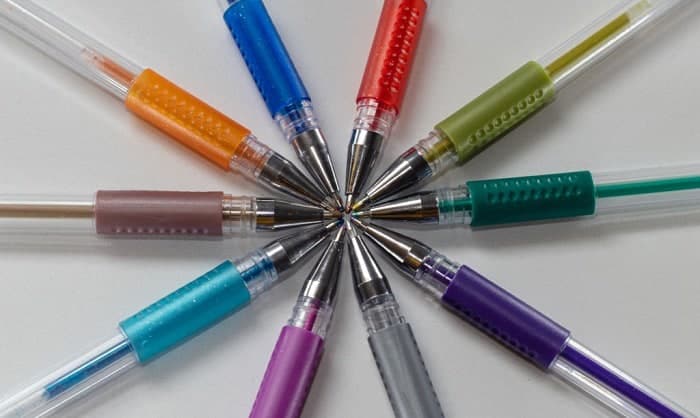
Gel pens have become a popular choice for everyday writing due to their smooth ink flow and vibrant array of colors. Their innovative formulation and design are exceptional features that stand out in the world of pens; however, this does not mean they do not experience any performance issues.
You are jotting down important notes with a gel pen and suddenly, it stops working. You tried shaking and scribbling on the paper to get some ink out of it. Even so, it does not work and you’re left wondering what went wrong. If you find this scenario familiar, do not toss your pen in the bin just yet! Luckily, there are easy ways on how to get a gel pen to work, prevent skipping, and prolong its efficient performance.
Table of Contents
- Easy Ways to Get a Gel Pen to Work Again
- Method 1: Give your pen a good shake
- Method 2: Go doodling and scribbling
- Method 3: Check for any nib crud buildup
- Method 4: Dip the pen nib in warm water
- Method 5: A small amount of warm or hot water inside the ink cartridge might work
- Method 6: Take a little amount of acetone and soak the tip in it
- Method 7: You can try rubbing alcohol
- Why Do Gel Pens Skip and Stop Working?
- Things to Avoid When Reviving Gel Pens
- Conclusion
Easy Ways to Get a Gel Pen to Work Again

When you see that the gel pen still has ink in it but has already stopped working, do not throw it away immediately and replace it with a new one. The good news is that there are useful tips and tricks for you to try to make it work again. Try the following:
Method 1: Give your pen a good shake
Sometimes, shaking it will solve the problem. This is probably one of the first things you would do when your gel pens start to skip or stop writing. As mentioned, one of the common issues is that the air gets inside the ink cartridge and blocks the smooth ink flow. As such, a few shakes will do the trick.
Instructions:
Step 1: Hold your gel pen right at the other end of the tip.
Step 2: Shake it nicely in an upward and downward motion, like you would when using a hand fan or paper fan. This allows you to unclog any potential air bubbles that might have gotten inside the ink cartridge.
Step 3: After a few shakes, try writing on scrap paper to check if some ink comes out.
Method 2: Go doodling and scribbling
When shaking does not work, another way to deal with it is to keep on scribbling and doodling. You can have a scribbling or scratch notebook where you can test your gel pens before writing or decorating anything.
Furthermore, the problem might not be as bad as having to throw it away. As mentioned, gel pens use a water-based ink that tends to dry out when you are not using it for a while. That is why you need to test and use it constantly to keep the pens from skipping.
Instructions:
Step 1: Take a piece of scratch paper.
Step 2: Simply use your pen as usual and keep on writing or drawing circles until you get consistent lines. In this way, you are basically “reactivating” the ink and getting it back to business.
Method 3: Check for any nib crud buildup
Gel pens are very fluid, which makes them easy to write or draw with. However, that also increases the chances of leaking, allowing the ink to stay on the pen nib or tip and solidify over time. This results in crud buildup that blocks the nib and prevents the pen from dispensing smooth ink flow.
Instructions:
Step1: Use your finger to check the nib for any crud buildup.
Step 2: If you notice there is any, you can gently take it off. Do not use any sharp object or knife that may scratch or damage the nib or tip of the pen.
Step 3: If there is any buildup around the tip, you can use a safety pin to take it off.
Step 4: Unscrew the tip of the gel pen and slowly insert the safety pin to remove the crud buildup.
Step 5: Try writing and scribbling on paper to check if it works.
Method 4: Dip the pen nib in warm water
When these simple tweaks and hacks do not seem to work, you might need to liquefy and eliminate the solidified ink in warm water.
Instructions:
Step 1: Prepare a small amount of warm water in a bowl.
Step 2: Unscrew the pen tip and take the ink cartridge out.
Step 3: Soak the nib in warm water for a few minutes. This will dissolve any solidified ink inside the nib and let the ink flow smoothly again.
Step 4: Put the ink cartridge back into the barrel and screw the tip on it.
Step 5: Test the gel pen on paper.
Method 5: A small amount of warm or hot water inside the ink cartridge might work
It only takes straightforward tricks and hacks to solve minor issues with your gel pen. However, when the entire ink or ink cartridge becomes the problem, you may need to try approaches apart from just soaking, shaking, or scribbling.
In some cases, the ink dries out and solidifies when you leave your gel pen unused for a long time. To solve this, you can put a small amount of warm or hot water to liquefy the ink and save it from drying out completely.
Instructions:
Step 1: Prepare a small amount of hot or warm water.
Step 2: Unscrew the pen cap and take the ink cartridge out of the barrel.
Step 3: Take the opposite side of the tip and use a dropper to pour just a pea-size amount of hot water inside the ink cartridge from its hole.
Step 4: Give the cartridge a few shakes and a quick blow. Do it slowly. This can dislodge any solidified ink and improve ink flow.
Step 5: Put it back in the barrel and place the tip as well.
Step6: Make a few scribbles to check the ink flow.
Method 6: Take a little amount of acetone and soak the tip in it
You can consider this step if the previous hacks do not work. Apart from removing nail polish, acetone is a type of chemical that can solvate substances and alter results, including unclogging a gel pen.
Instructions:
Step 1: Prepare a small amount of acetone.
Step 2: Dip the tip of your gel pen in it for a few seconds. Do not soak it for too long to avoid any abrasive reactions to the tip.
Step 3: Wipe the tip dry with a soft cloth.
Step 4: Test it on paper with a few scribbles.
Method 7: You can try rubbing alcohol
Using rubbing alcohol is almost similar to using acetone, only alcohol is a milder type of solvent. Nonetheless, it can work as efficiently to dissolve any crud buildup inside the ink cartridge and enhance seamless ink flow.
Instructions:
Step 1: Get a small amount of rubbing alcohol.
Step 2: Soak the pen tip in it for a few seconds. Since it also contains chemicals that might damage the pen tips, you should not dip your gel pen in it for a long time.
Step 3: Use a soft cloth to wipe it clean and dry.
Step 4: Scribble on paper to check if any ink comes out.
Why Do Gel Pens Skip and Stop Working?

Before trying any unclogging hacks and/or performance tweaks, the first thing to do is rule out the common problems of why gel pens sometimes malfunction:
They are prone to drying out: Gel pens use either thick or thin water-based ink that tends to dry out easily when left unused for a long time, which leads to clogging. When this happens, a gel pen would start skipping or worse, would not write anymore.
The air can disrupt smooth ink flow: If you often forget to put the cap back or retract your pen after use, you are letting the air get inside the ink cartridge. As a result, air bubbles will form, and this can block ink flow, causing the pen to skip and eventually wear out.
Improper storage: How do you put your pens away after using them? If you just leave them on your desk without their caps on or store them upside down for long periods, that could be a problem.
Gel pens use water-based inks that are prone to leaking so it is best to store them in an upright position. Aside from that, it is important to keep their caps on at all times to prevent the ink from drying out quickly.
Things to Avoid When Reviving Gel Pens
Before you try any of these steps, there are some things you should not do:
- Do not use steaming hot water if you are going to dip your gel pen in it. This might melt the ink cartridge and damage it rather than fixing it. If the water is too hot, you can put the pen tip or nib over the steam to unclog the ink cartridge.
- Do not tap the pen or scribble too hard to get some ink out of it.
- Do not put it over a fire to dislodge potential air bubbles inside the cartridge. This will melt the cartridge and cause possible hand burns.
- Do not use very sharp objects to scrape off the nib crud to avoid damages to your pen.
- Do not use too much acetone. Since it has a very strong smell, you should use it in a well-ventilated area.
Conclusion
What do you think of these tips? Which one should you try first?
Overall, when your gel pens skip and stop working, it might not be a hopeless case. There are some tweaks and easy tips on how to get a gel pen to work and get your gel pens back to their working condition. Just remember that before you try any of these, make sure to identify the issue first. In this way, you will know for sure what you need to do.

I am a former art teacher, so it is evident to me the importance of art in educating the new generation. We also want to help parents who plan to teach their children and desire the best tools and tips for them.